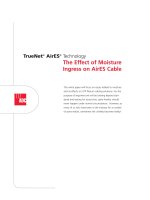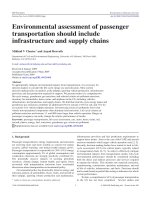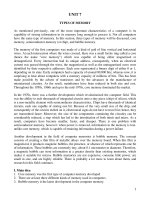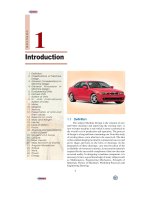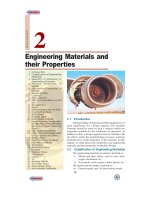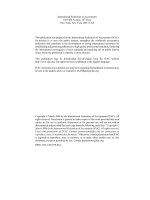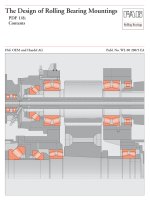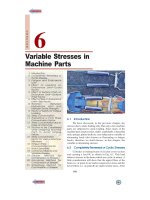Tài liệu Environmental assessment of passenger docx
Bạn đang xem bản rút gọn của tài liệu. Xem và tải ngay bản đầy đủ của tài liệu tại đây (1.12 MB, 8 trang )
IOP P
UBLISHING
E
NVIRONMENTAL
R
ESEARCH
L
ETTERS
Environ. Res. Lett. 4 (2009) 024008 (8pp) doi:10.1088/1748-9326/4/2/024008
Environmental assessment of passenger
transportation should include
infrastructure and supply chains
Mikhail V Chester
1
and Arpad Horvath
Department of Civil and Environmental Engineering, University of California, 760 Davis Hall,
Berkeley, CA 94720, USA
E-mail: and
Received 6 January 2009
Accepted for publication 5 May 2009
Published 8 June 2009
Online at stacks.iop.org/ERL/4/024008
Abstract
To appropriately mitigate environmental impacts from transportation, it is necessary for
decision makers to consider the life-cycle energy use and emissions. Most current
decision-making relies on analysis at the tailpipe, ignoring vehicle production, infrastructure
provision, and fuel production required for support. We present results of a comprehensive
life-cycle energy, greenhouse gas emissions, and selected criteria air pollutant emissions
inventory for automobiles, buses, trains, and airplanes in the US, including vehicles,
infrastructure, fuel production, and supply chains. We find that total life-cycle energy inputs and
greenhouse gas emissions contribute an additional 63% for onroad, 155% for rail, and 31% for
air systems over vehicle tailpipe operation. Inventorying criteria air pollutants shows that
vehicle non-operational components often dominate total emissions. Life-cycle criteria air
pollutant emissions are between 1.1 and 800 times larger than vehicle operation. Ranges in
passenger occupancy can easily change the relative performance of modes.
Keywords:
passenger transportation, life-cycle assessment, cars, autos, buses, trains, rail,
aircraft, planes, energy, fuel, emissions, greenhouse gas, criteria air pollutants
S
Supplementary data are available from stacks.iop.org/ERL/4/024008
1. Background
Passenger transportation’s energy requirements and emissions
are receiving more and more scrutiny as concern for energy
security, global warming, and human health impacts grows.
Passenger transportation is responsible for 20% of US energy
consumption (approximately 5% of global consumption) and
combustion emissions are strongly positively correlated [1].
The potentially massive impacts of securing petroleum
resources, climate change, human health, and equity issues
associated with transportation emissions have accelerated
discussions about transportation environmental policy.
Governmental policy has historically relied on energy and
emission analysis of automobiles, buses, trains, and aircraft at
their tailpipe, ignoring vehicle production and maintenance,
1
Author to whom any correspondence should be addressed.
infrastructure provision and fuel production requirements to
support these modes. Such is the case with CAFE and aircraft
emission standards which target vehicle operation only [2, 3].
Recently, decision-making bodies have started to look to life-
cycle assessments (LCA) for critical inputs, typically related
to transportation fuels [4, 5]. In order to effectively mitigate
environmental impacts from transportation modes, life-cycle
environmental performance should be considered including
both the direct and indirect processes and services required
to operate the vehicle. This includes raw materials extraction,
manufacturing, construction, operation, maintenance, and end
of life of vehicles, infrastructure, and fuels. Decisions should
not be made based on partial data acting as indicators for whole
system performance.
To date, a comprehensive LCA of passenger transportation
in the US has not been completed. Several studies and
1748-9326/09/024008+08
$
30.00
©
2009 IOP Publishing Ltd Printed in the UK
1
Environ. Res. Lett. 4 (2009) 024008 M V Chester and A Horvath
models analyze a single mode, particular externalities, or
specific phases, but none have performed a complete LCA
of multiple modes including vehicle, infrastructure, and fuel
inventories for energy consumption, greenhouse gas emissions,
and criteria air pollutant emissions incorporating supply
chains [6–9]. The automobile has received the greatest
attention while buses, rail, and air have received little focus.
A review of environmental literature related to the three modal
categories is shown in table S1 of the supporting information
(SI) (available at stacks.iop.org/ERL/4/024008).
2. Methodology
Onroad, rail, and air travel are inventoried to determine energy
consumption, greenhouse gas (GHG) emissions, and criteria
air pollutant (CAP) emissions (excluding PM, lead, and ozone
due to lack of data). The onroad systems include three
automobiles and two urban buses (off-peak and peak). A sedan
(2005 Toyota Camry), SUV (2005 Chevrolet Trailblazer),
and pickup (2005 Ford F-150) are chosen to represent the
range in the US automobile fleet and critical performance
characteristics [10–12]. 83% of rail passenger kilometers
are performed by metropolitan systems (with Amtrak serving
the remaining) [1]. The generalized rail modes (heavy
rail electric metro, heavy rail diesel commuter transit, and
light rail transit (LRT)) are chosen to capture the gamut
of physical size, fuel input, and service niche. The metro
and commuter rail are modeled after the San Francisco Bay
Area’s (SFBA) Bay Area Rapid Transit and Caltrain while
the LRT modes are modeled after San Francisco’s (SF)
Muni Metro and the Boston Green Line. Air modes are
evaluated by small (Embraer 145), midsize (Boeing 737) and
large (Boeing 747) aircraft to represent the range of impacts
from aircraft sizes, passenger occupancy, and short to long
haul segment performance [13]. An extended discussion
of the characteristics and representativeness of the modes
selected is found in the SI. US average data are used for all
onroad and air mode components and particular geographic
operating conditions are not captured [14, 15]. Rail operational
performance is determined from specific systems [15–18].
A hybrid LCA model was employed for this analysis [19].
The use of this LCA approach is discussed in the SI and
detailed extensively in [20]. The life-cycle phases included
are shown in table 1. The components are evaluated from the
materials extraction through the use phase including supply
chains. For example, the manufacturing of an automobile
includes the energy and emissions from extraction of raw
materials such as iron ore for steel through the assembly of that
steel in the vehicle. End-of-life phases are not included due
to the complexities of evaluating waste management options
and material reuse. Indirect impacts are included, i.e., the
energy and emissions resulting from the support infrastructure
of a process or product, such as electricity generation for
automobile manufacturing.
For each component in the mode’s life cycle, environ-
mental performance is calculated and then normalized per
passenger-kilometer-traveled (PKT). The energy inputs and
emissions from that component may have occurred annually
(such as from electricity generation for train propulsion) or
over the component’s lifetime (such as train station construc-
tion) and are normalized appropriately. Detailed analyses and
data used for normalization are found in [20], including mode-
specific adjustments (such as the removal of freight and mail
attributions from passenger air travel). Equation (1) provides
the generalized formula for determining component energy or
emissions.
E
M
=
C
c
EF
M,c
× U
M,c
(t)
PKT
M
(t)
(1)
where
E
M
is total energy or emissions per PKT for
mode
M
;
M
is the set of modes
{
sedan, train, aircraft, etc
}
;
c
is vehicle, infrastructure, or fuel life-cycle component;
EF is environmental (energy or emission) factor for
component
c
;
U
is activity resulting in EF for component
c
;
PKT is PKT performed by mode
M
during time
t
for
component
c
.
The fundamental environmental factors used for deter-
mining a component’s energy and emissions come from a
variety of sources. They are detailed in SI tables S2–S4
(available at stacks.iop.org/ERL/4/024008). Further, each
component’s modeling details are discussed in [20]which
provides the specific mathematical framework used as well as
extensive documentation of data sources and other parameters
(such as component lifetimes and mode vehicle and passenger
kilometers traveled). Parameter uncertainty is also evaluated in
the SI.
Results for modal average occupancy per-PKT perfor-
mance are reported. While understanding of marginal perfor-
mance is necessary for transportation planners to evaluate the
additional cost of a PKT given a vested infrastructure and the
assumption that many public transit trips will occur regardless,
the average performance characteristics allow for the total
environmental inventorying of a system over its lifetime.
3. Results and component comparisons
With 79 components evaluated across the modes, the groupings
in table 1 are used to report and discuss inventory results.
3.1. Energy
The energy inputs for the different systems range from direct
fossil fuel use such as gasoline, diesel, and jet fuel to indirect
fossil fuel use in electricity generation. The non-operational
vehicle phases use a combination of energy inputs for direct
and indirect requirements. For example, the construction of
an airport runway requires direct energy to transport and place
the concrete and indirect energy to extract and process the raw
materials. Figure 1 shows total energy inputs for each mode.
While tailpipe components account for a large portion
of modal life-cycle energy consumption, auto and bus non-
operational components have non-negligible results. Active
operation accounts for 65–74% of onroad, 24–39% of rail,
and 69–79% of air travel life-cycle energy. Inactive operation
accounts for 3% of bus, 7–21% of rail, and 2–14% of air
2
Environ. Res. Lett. 4 (2009) 024008 M V Chester and A Horvath
Table 1 . Analysis components (for each component, energy inputs and emissions are determined. The components are shown by generalized
mode, but evaluated independently for each system).
Grouping Automobiles and buses Rail Air
Vehicles
Operational components
Active operation
•
Running
•
Cold start
•
Running
•
Take off
•
Climb out
•
Cruise
•
Approach
•
Landing
Inactive operation
•
Idling
•
Idling
•
Auxiliaries (HVAC and lighting)
•
Auxiliary power unit operation
•
Startup
•
Taxi out
•
Taxi in
Non-operational components
Manufacturing (facility
construction excluded)
•
Vehicle manufacturing
•
Engine manufacturing
•
Train manufacturing
•
Propulsion system
manufacturing
•
Aircraft manufacturing
•
Engine manufacturing
Maintenance
•
Vehicle maintenance
•
Tire replacement
•
Train maintenance
•
Train cleaning
•
Flooring replacement
•
Aircraft maintenance
•
Engine maintenance
Insurance
•
Vehicle liability
•
Crew health and benefits
•
Train liability
•
Crew health and benefits
•
Aircraft liability
Infrastructure
Construction
•
Roadway construction
•
Station construction
•
Track construction
•
Airport construction
•
Runway/taxiway/tarmac
construction
Operation
•
Roadway lighting
•
Herbicide spraying
•
Roadway salting
•
Station lighting
•
Escalators
•
Train control
•
Station parking lighting
•
Station miscellaneous
(e.g., other electrical equipment)
•
Runway lighting
•
Deicing fluid production
•
Ground support equipment
operation
Maintenance
•
Roadway maintenance
•
Station maintenance
•
Station cleaning
•
Airport maintenance
Parking
•
Roadside, surface lot, and
parking garage parking
•
Station parking
•
Airport parking
Insurance
•
Non-crew health insurance and
benefits
•
Infrastructure liability insurance
•
Non-crew health and benefits
•
Infrastructure liability
Fuels
Production
•
Gasoline and diesel fuel
refining and distribution (includes
through fuel truck delivery
stopping at fuel station. Service
station construction and
operation is excluded)
•
Train electricity generation
•
Train diesel fuel refining and
distribution (Caltrain)
•
Train electricity transmission and
distribution losses
•
Infrastructure electricity
production
•
Infrastructure electricity
transmission and distribution losses
•
Jet fuel refining and distribution
modes. The automobile and bus non-operational components
are dominated by electricity production, steel production, and
truck and air transport of materials in vehicle manufacturing
and maintenance [20]. The construction of the US road
and highway infrastructure has large energy implications (in
material extraction, material production, and construction
operations), between 0.3 and 0.4 MJ
/
PKT for autos [21–23].
Rail modes have the smallest fraction of operational to
total energy due to their low electricity requirements per
PKT relative to their large supporting infrastructures [20].
The construction and operation of rail mode infrastructure
results in total energy requirements about twice that of
operational.
Aircraft have the largest operational to total life-cycle
energy ratios due to their large fuel requirements per PKT
and relatively small infrastructure. The active and inactive
operational groupings include several components (table 1)and
energy consumption is dominated by the cruise phase [24, 25].
3
Environ. Res. Lett. 4 (2009) 024008 M V Chester and A Horvath
Figure 1. Energy consumption and GHG emissions per PKT (The vehicle operation components are shown with gray patterns. Other vehicle
components are shown in shades of blue. Infrastructure components are shown in shades of red and orange. The fuel production component is
shown in green. All components appear in the order they are shown in the legend.).
3.2. Greenhouse gases
The energy inputs described are heavily dominated by fossil
fuels resulting in a strong positive correlation with GHG
emissions. The life-cycle component contributions are roughly
the same as the GHG contributions and produce 1.4–1.6 times
larger life-cycle factors for onroad, 1.8–2.5 times for rail, and
1.2–1.3 times for air than the operational components. Total
emissions for each mode are shown in figure 1.
While the energy input to GHG emissions correlation
holds for almost all modes, there is a more pronounced effect
between the California (CA) and Massachusetts (MA) LRT
systems. The San Francisco Bay Area’s electricity is 49%
fossil fuel-based and Massachusetts’s is 82% [26, 27]. The
result is that the Massachusetts LRT, which is the lowest
operational energy user and roughly equivalent in life-cycle
energy use to the other rail modes, is the largest GHG emitter.
3.3. Criteria air pollutants
Figure 2 shows SO
2
,NO
X
, and CO emissions for each
life-cycle component. The inclusion of non-operational
components can lead to an order of magnitude larger emission
factor for total emissions relative to operational emissions.
3.3.1. SO
2
contributors. Electricity generation SO
2
emissions dominate life-cycle component contributions for all
modes. While electric rail modes have large contributions
from vehicle operation components, this is not the case for
autos, buses and commuter rail due to the removal of sulfur
from gasoline and diesel fuels. Low sulfur levels in fuels
result in low SO
2
emissions from fuel combustion compared to
the relatively large SO
2
emissions from electricity generation
in other components. Total automobile SO
2
emissions are
19–26 times larger than operational emissions and are due to
vehicle manufacturing and maintenance, roadway construction
and operation (particularly lighting), parking construction, and
gasoline production. The electricity requirements in vehicle
manufacturing, vehicle maintenance, roadway lighting, road
material production, and fuel production (as well as off-gasing)
result in significant SO
2
contributions [20, 21, 26, 28]. Bus
emissions are dominated by vehicle manufacturing, roadway
maintenance [21], and fuel production. Vehicle manufacturing,
infrastructure construction, infrastructure operation, parking,
insurance, and fuel production produce emission factors
for rail modes that are 2–800 times (assuming Tier 2
standards) larger than operational components. The majority of
vehicle manufacturing emissions result from direct electricity
4
Environ. Res. Lett. 4 (2009) 024008 M V Chester and A Horvath
Figure 2. Criteria air pollutant emissions in mg per PKT (The vehicle operation components are shown with gray patterns. Other vehicle
components are shown in shades of blue. Infrastructure components are shown in shades of red and orange. The fuel production component is
shown in green. All components appear in the order they are shown in the legend.).
requirements in assembling the parts as well as the energy
requirements to produce steel and aluminum for trains.
Total aircraft SO
2
emissions are composed of 64–71% non-
operational emissions, and are attributed mostly to the direct
electricity requirements in aircraft manufacturing and indirect
electricity requirements in the extraction and refinement of
copper and aluminum [20].
3.3.2. NO
X
contributors. Life-cycle NO
X
emissions are
often dominated by tailpipe components, however, autos and
electric rail modes show non-negligible contributions from
other components. Non-operational NO
X
emissions are due
to several common components from the supply chains of
all the modes: direct electricity use, indirect electricity use
for material production and processes, and truck and rail
transportation. With onroad modes, electricity requirements
for vehicle manufacturing and maintenance as well as truck
and rail material transport are large contributors [20]. The
transport of materials for asphalt surfaces is the primary culprit
in roadway and parking construction [21]. Fuel refinery
electricity and diesel equipment use in oil extraction add to
the component’s contribution to total emissions [20]. For
rail, the dependence on concrete in infrastructure (resulting in
large electricity requirements for cement manufacturing and
diesel equipment use in placement) impacts the contribution
from construction and maintenance increasing total NO
X
emissions by 2.4–12 times for the electric modes and 1.1
times for commuter rail. Aircraft manufacturing, infrastructure
operation, and fuel production produce emissions from aircraft
that are 1.2 times larger than operational emissions. The direct
electricity requirements and truck and rail transport are the key
components in aircraft manufacturing.
3.3.3. CO contributors. While automobile CO emissions
are dominated by the vehicle operation phase, this is not the
case for bus, rail, and air modes. Automobile CO emissions
5
